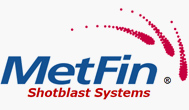Shotpeening is a cold working process used to improve the characteristics of metal parts. The basic premise is that small, round media are directed at a part to create dimples on the surface which puts the outer layer of the metal into compression and effectively prevents fatigue failure and stress corrosion cracking. Correctly creating these dimples is the secret to achieving an effective shot peening process.
To set up a successful shotpeening operation, the first step is to review the part to be peened:
- What material is the part made from?
- How big is the part?
- How hard is the material the part is made from?
- Does the part have any unusual features?
Media
With this information in hand, the next step is to determine the media to be used. There are many types of media available and the AMS Media General Requirements is the best tool for making an informed media choice:
| Specification | Material | Classification | Type of Parts to be Shot Peened |
| AMS 2431/1 | Regular Hardness Cast Steel Shot | ASR | Most common peening media |
| AMS 2431/2 | High Hardness Cast Steel Shot | ASH | High hardness parts |
| AMS 2431/3 | Cut Wire Shot | AWCR | High volume parts |
| AMS 2431/4 | Stainless Steel Cut Wire Shot | AWS | Parts sensitive to iron contamination |
| AMS 2431/5 | Steel Peening Balls | High intensity parts | |
| AMS 2431/6 | Glass Shot | Non-ferrous parts | |
| AMS 2431/7 | Ceramic Shot | Non-ferrous parts |
Media is available in many sizes. The size recommended for each process comes from the Almen intensity specified on the drawing. The higher the intensity requirement, the larger the media. The size of the media is limited in that the media can be no larger than half of the smallest fillet radius.
Peening Method – Air Blast Nozzles or Centrifugal Wheel Blast
With the media determined, the next step is to choose how to accelerate the media at the parts to be peened. The most common method is to use compressed air to propel the media through multiple blast nozzles. The advantage of the compressed air method is the flexibility it allows in focusing the flow of shot. Media can be focused at specific angles of a part or set up to cover a broad area. Another option is to utilize a centrifugal blast wheel machine which can throw a lot more media, but it is less targetable. Blast wheels speed up the process significantly, but are limited to peening simple shapes.

Equipment Set Up and Process Validation
One of the most important steps in shotpeening is the design of the Almen fixture. The Almen fixture is utilized to set up the equipment and to validate the process. Almen test strips are attached to the fixture in a manner that simulates the surface of the part to be peened. It is important that the areas on the part which are critical are accurately represented by the Almen fixture. Often a damaged or rejected part is used for this purpose as it very accurately represents a real part.
The object of peening the Almen strips is to establish the saturation point, this is the point at which 100% coverage occurs. This is accomplished by running sets of Almen strips for different lengths of time to form a curve. When the difference in intensity on the strips is less than 10% when the time is doubled, you have reached saturation. This means that the two parameters of intensity and coverage have been met. If there are multiple strips on a fixture, an attempt should be made to have saturation occur at the same time on all strips.
Once the Almen curves have been run and all are compliant with the drawing requirements, the process is now set up to begin shot peening the final product. The setup that was used to peen the Almen curves should now be used to peen the part. Depending on the hardness of the part and the coverage specification, the peening time will either be longer or shorter than the time for the strips.
If the Almen fixture accurately represented the part, then 100% coverage on the part will be similar to 100% coverage on the Almen fixture. The ACTUAL peening time is dictated by the requirements of the drawing and can range from 100% to 600%. After peening is complete, care should be taken not to heat the parts above set limits.
Post Peen Cleaning
Steel parts do not need to be chemically cleaned, but care needs to be taken not to scratch or erode the peened surface. Aluminum and Titanium parts need to be chemically cleaned after peening. Shotpeened parts are extremely susceptible to corrosion and should be protected from it.

